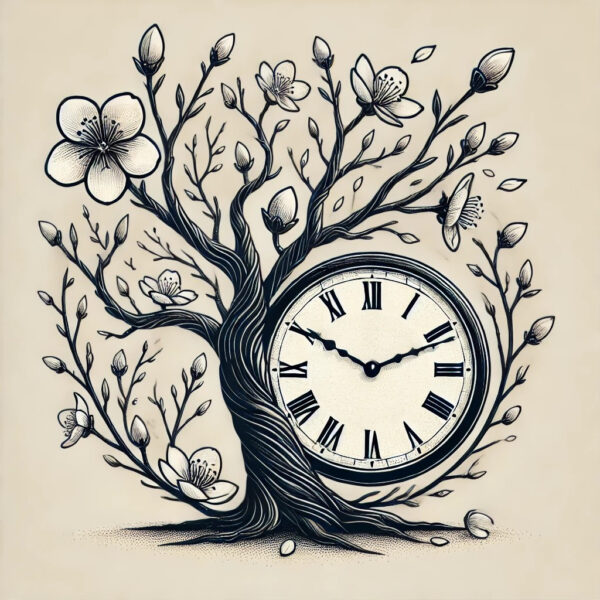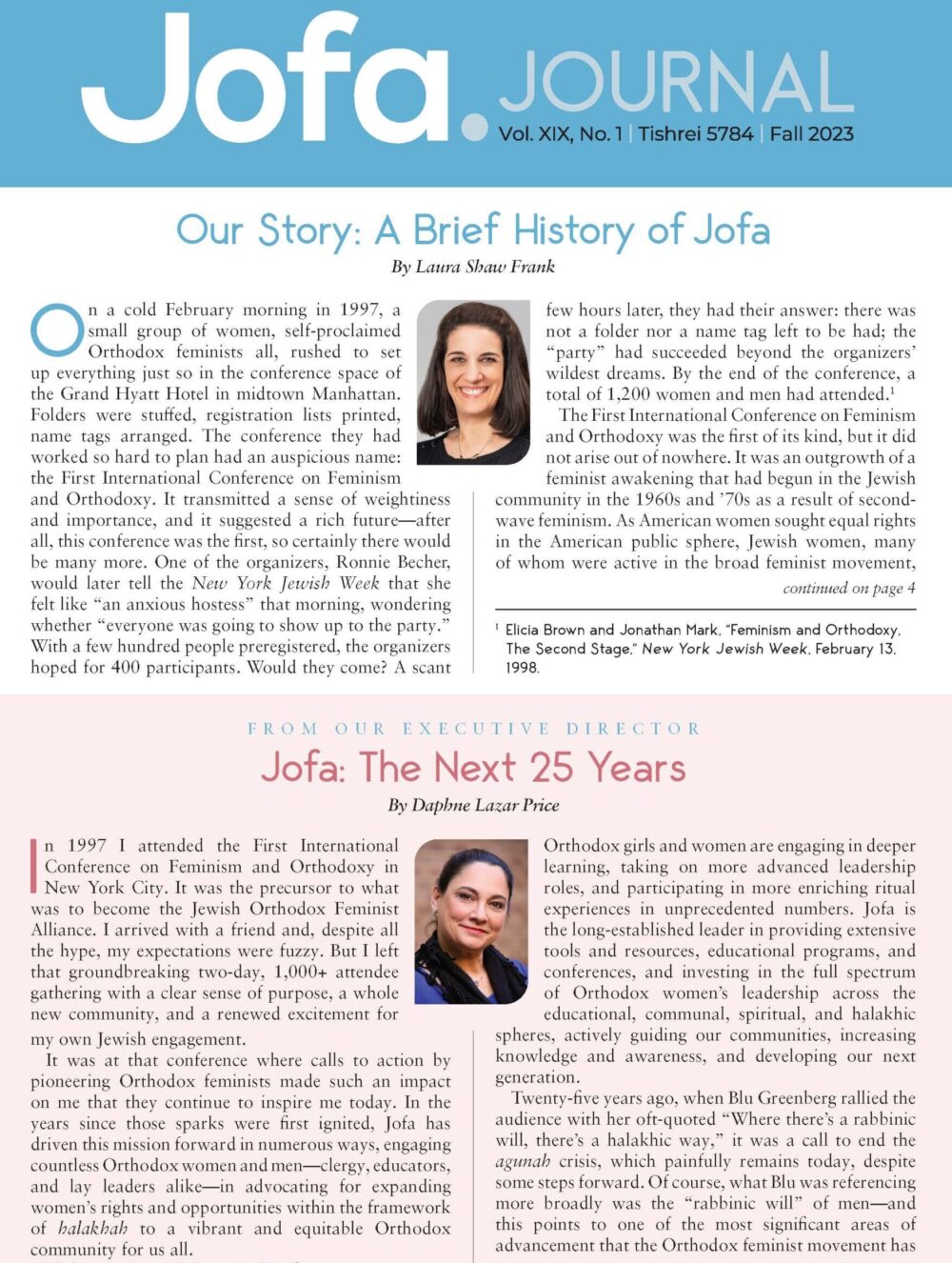By Wendy Lefko Messeloff
Claim your seat at the table. Join the Jofa newsletter at the bottom of this page to receive weekly updates directly to your inbox.
It can be frightening to think about the passing of time in our current moment. Months spent in captivity, on the battlefront, evacuated from home, living in fear, anguish, heartbreak, mourning, trauma. Time can feel like a cruel symbol of the pain and hurt that we as a Jewish people have been experiencing. But this week’s parsha, finding us at a critical juncture in the war, offers a very different lens for thinking about time.
Parshat Bo contains one of the most transformative mitzvot given to the Jewish people — a mitzvah designated in time: “HaChodesh hazeh lachem rosh chadashim” (“This month shall be for you the head of the months”) (Shemot 12:2). With this command, Hashem establishes the month of Nisan, the time of the Exodus, as the beginning of the Jewish calendar.
On the surface, this seems intuitive. Nisan marks the birth of the Jewish people as a nation, the moment we were redeemed from slavery and began our journey to serve our God as a free people. It is fitting that this transformative moment would inaugurate the Jewish year.
Yet we know that on the Jewish calendar it is Rosh Hashanah that we celebrate as our “official” new year, nearly six months later in Tishrei. How do we reconcile these two beginnings? Why do we mark Nisan as the first of months, while celebrating Rosh Hashanah in Tishrei? This duality beckons us to delve into the deeper meaning and significance of time in our Jewish lives.
Rashi, quoting the Midrash (Shemot 12:2), explains that this mitzvah of sanctifying the new moon was the first mitzvah given to the Jewish people as a nation. It established our ability to determine the calendar and sanctify time. This power symbolizes our partnership with Hashem in shaping the spiritual framework of the world. By starting the year in Nisan, the Torah emphasizes the primacy of redemption and spiritual rebirth in our national identity. Nisan reminds us of Hashem’s direct intervention in history and the miraculous transformation from slavery to freedom. By contrast, Tishrei aligns with creation, marking the anniversary of the world’s formation and Hashem’s coronation as King of the universe.
Ramban (Shemot 12:2) notes that Nisan represents the national relationship between Hashem and the Jewish people, rooted in miracles and redemption, while Tishrei reflects the universal relationship between Hashem and all of creation, grounded in nature and the natural order. Thus, the Jewish calendar holds space for both themes: our particular mission as a redeemed nation, and our universal role as stewards of Hashem’s creation.
Rabbeinu Bachya adds another dimension, emphasizing that time in Judaism is cyclical, not linear. The designation of Nisan as the first month reflects the cyclical nature of spiritual growth, where redemption is not a one-time event, but a recurring opportunity — a powerful chidush to consider.
Similarly, Maharal explains that the dual heads of the year highlight two distinct aspects of time: Nisan as “z’man geulah” (“time of redemption”) and Tishrei as “z’man din” (“time of judgment”). This structure urges us to constantly revisit the themes of renewal and accountability throughout our lives. In the words of Rebbe Nachman of Breslov (Sichot HaRan, 48), to “begin anew, even many times each day.”
Rav Soloveitchik expands on this idea, exploring the different modes of time in Judaism. Nisan represents “experiential time,” moments of personal and national transformation, where Hashem’s presence feels immediate, and history shifts dramatically — as in the Exodus. Tishrei, on the other hand, reflects “objective time,” the steady rhythm of the natural world, inviting introspection and recognition of Hashem’s sovereignty over all existence. Together, these two cycles teach us that Jewish time oscillates between moments of extraordinary spiritual renewal and the continuous, quieter work of self-refinement and connection to Hashem’s will.
In addition to these two new years, the Jewish calendar includes a third new year — Tu B’Shevat, the new year for trees — which is approaching soon. (Rosh Chodesh Shevat is today, Thursday, January 30, and Tu B’Shevat follows in two weeks, on Thursday, February 13.) Tu B’Shevat emphasizes growth, renewal, and our deeply rooted connection to the land of Israel. It serves as a reminder that just as trees go through cycles of dormancy and renewal, so too do we experience cycles of personal and national growth.
Tu B’Shevat connects with Nisan in its theme of renewal and redemption, as it marks the early stirrings of spring, particularly in Israel. At the same time, it reflects an aspect of Tishrei in its connection to nature and the world’s continuous development. Thus, this third new year highlights yet another layer of how we sanctify time — not only in relation to human history, but also in the broader context of the natural world, and our role as caretakers of Hashem’s creation.
(It is worth noting here how richly symbolic trees are. They also remind us of the importance of ensuring that we plant for the next generation, sowing seeds that may not bear fruit for us, but rather for our children and grandchildren. Like personal growth, the growth of trees requires vision, diligence, time, and patience. Just the same, once a tree bears fruit, there is no time to waste: the fruit must be picked while it remains fresh, and in order to make way for new growth.)
The plurality of new years in Nisan, Tishrei, and Shevat speaks to the balance between action and reflection. Nisan inspires us to act, to seize opportunities for redemption and renewal. Tishrei calls us to pause, to reflect on our deeds and reaffirm our commitment to Hashem. Shevat asks us to both act and pause, just as we plant and we wait cyclically.
By sanctifying these times, the Torah acknowledges that a meaningful Jewish life requires them all: the capacity to act decisively in moments of change, the ability to reflect and realign our lives with transcendent divine values, and the wisdom to strike the balance. The growth of trees is an apt metaphor, requiring both the actions of planting, feeding, and watering, as well as the interspersed time spent waiting, during which we cannot actively hasten the tree’s growth.
Parshat Bo reinforces the sanctity of time and the responsibility we hold in shaping it. Nisan, Tishrei, and Shevat are not simply calendar markers; they are spiritual guideposts, teaching us to embrace both the miraculous and the mundane, the universal and the particular. Together, they form the rhythm of Jewish life, a cycle that tangibly connects us to Hashem, our history, our present, and our future.
This sensitivity to time resonates acutely in our current moment. We count the days, weeks, and months since the hostages have been held in Gaza, longing for their freedom and praying fervently for their safe return. Their slow release now, after what feels like an eternity, reminds us of the Exodus itself — a time of darkness and suffering giving way to redemption, at just the moment when the first almond trees emerge from their winter slumber and begin to blossom in our homeland. The Jewish people have always been profoundly aware of the sanctity of time, using it to mark pain and hope alike. May this period soon be remembered as one of ultimate redemption, where those in captivity are reunited with their families, and we, as a nation, can once again sanctify time in joy and unity.
Chodesh Tov ~ Shabbat Shalom
Besorot Tovot ~ Am Yisrael Chai










